Table of Contents
Table of Contents
Buyers guide to commercial security camera systems
Choosing the right commercial security camera system is essential for protecting your business, employees, and assets. With so many options—wired vs. wireless, cloud vs. on-site storage, AI-powered analytics, and more—it can be overwhelming to know where to start.
This guide breaks down everything you need to know, from the types of cameras available to key features in a video management system (VMS). Whether you’re upgrading an existing system or investing in security cameras for the first time, this buyer’s guide will help you make an informed decision.
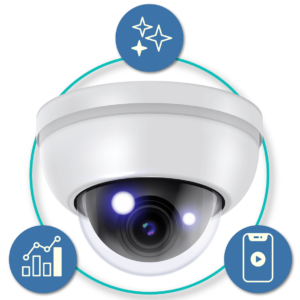
The evolution of commercial security camera systems
Commercial security cameras have advanced significantly, moving from basic analog systems to powerful, AI-driven solutions. Early systems relied on CCTV cameras with limited resolution, requiring businesses to store hours of footage on bulky VHS tapes or DVRs. Retrieving video was time-consuming, and camera coverage was often limited.
The shift to digital and IP-based cameras changed everything. Higher resolutions, cloud storage, and remote access gave businesses greater control and visibility. Today’s systems offer AI-powered analytics, real-time alerts, and integration with video management systems (VMS), transforming security from passive recording to active threat detection.
Understanding this evolution helps businesses invest in smarter, more efficient security solutions that improve safety, reduce risk, and streamline operations.
Why commercial security camera systems are necessary
A commercial security camera system is more than just a safety measure—it’s a critical tool for protecting your business, employees, and assets. Without proper security, businesses face risks like theft, vandalism, fraud, and liability claims, which can lead to significant financial losses.
Modern security camera systems help deter crime, provide clear evidence in disputes, and ensure compliance with safety regulations. They also improve operational efficiency by monitoring employee productivity and customer behavior. With features like remote access and AI-powered alerts, businesses can respond to incidents in real time, reducing downtime and preventing losses.
Investing in a commercial security camera system isn’t just about security—it’s about gaining better control, reducing risk, and ensuring peace of mind.
Core features of commercial security camera systems
The right commercial security camera system goes beyond just recording video. Three key features make a system truly effective:
- High-quality cameras – Choosing the right type, from bullet to 360-degree cameras, ensures full coverage.
- Video management system (VMS) – A VMS helps store, organize, and analyze footage for better security and efficiency.
- Storage solutions – Cloud, on-site, or hybrid storage ensures businesses can access and retain footage as needed.
Each of these features plays a crucial role in protecting your business, improving response times, and streamlining operations.
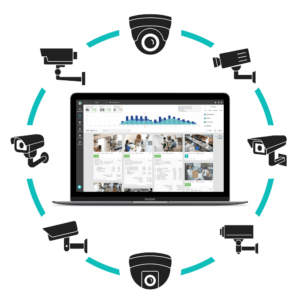
Protect your business today with Solink
Solink’s video analytics and security for businesses makes it easy to create a safe, secure, and healthy environment.
Schedule a product demo with our experts
Best commercial security cameras to use
Analog cameras
Analog cameras can sometimes be considered old technology when compared to newer IP cameras. For example, analog security cameras are usually capped to standard definition (SD) video quality. Standard definition is lower quality and has a pixel height of only 480p. However, they tend to be reliable and have been the mainstay of video security for decades. Solink is absolutely able to work with most analog as well as Internet Protocol (IP) cameras, so there’s no need to upgrade your entire commercial security camera infrastructure to work with its platform.
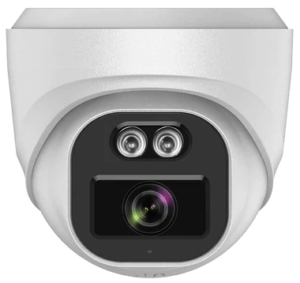
TVI cameras
Transport video interface (TVI) is a way of transmitting analog video over a coaxial cable. It is one of several technologies that can push analog cameras into high definition (HD). In addition to higher definition recordings, TVI provides a longer wired transmission range. Standard analog security cameras (sometimes called composite video baseband signal (CVBS)) have a maximum wired transmission range of 300 ft. However, some of the newer technologies, including TVI, increase the transmission range up to 900 ft.
IP cameras
Internet protocol cameras (IP cameras) are controlled using an IP network and transmit data digitally. By using the IP networking standards, some IP cameras can work without needing any local storage. However, regulations may require you to keep storage on premise regardless. Furthermore, Internet bandwidth is not always perfectly stable, so having a cloud with local storage solution is more reliable. IP cameras can connect to a network in two main ways: WiFi or a power over Ethernet (PoE) cable. PoE cables provide both power and network access for transmission and reception. If WiFi is chosen, then the cameras will still need to be powered, either using a battery or being plugged in through an adapter.
Wireless cameras
Wireless commercial security cameras transmit the video feed wirelessly. They still require power. Although there are battery- or solar-powered commercial security cameras, they tend to only be used where electricity is impractical. Both digital and analog commercial security cameras can be wireless. Wireless analog cameras connect to the network using an RF signal. Note that RF signals are less reliable than WiFi because cell phones and other nearby devices can interfere with the signal.
Bullet cameras
Bullet cameras are some of the most common commercial security cameras on the market. They are small and get their name from their shape. Their small size and easy installation make them particularly versatile. You can find them indoors and outdoors, and they are usually less noticeable than larger security cameras (e.g., the turret security cameras discussed next). However, their shape makes them less robust to vandalism than dome cameras (see below). See more about bullet vs. turret cameras here.
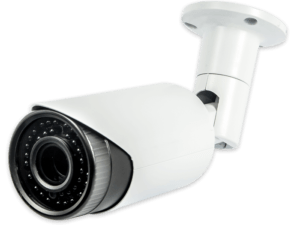
Turret cameras
Turret security cameras have a ball-and-socket design. Within the “turret”, the ball-like camera can be positioned to look at different angles. This makes their installation and re-positioning flexible. However, once installed, you’ll need to physically reposition the camera to get a new field of view.
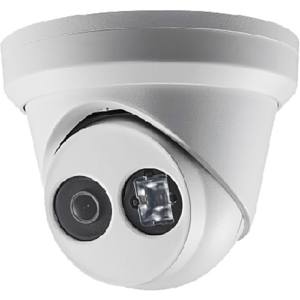
Dome cameras
Dome cameras are cameras covered with a dome. This obscures the direction they are facing, which can make employees and customers less sure what is or is not in the camera’s field of view. Their shape and the dome protection make them more resistant to vandalism. However, as with many of the other cameras on this list, it has a fixed viewing angle that cannot be changed remotely. See more about dome cameras vs. bullet cameras here.

PTZ cameras
PTZ stands for pan, tilt, zoom, and that’s basically what they can do. PTZ security cameras can be controlled remotely to pan across a larger area or zoom in on something in particular. This added functionality usually comes with a higher price tag. However, you might be able to offset the added cost per camera by using fewer cameras in total.
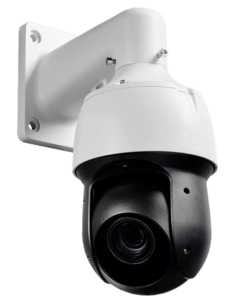
360 degree cameras (fisheye cameras)
360 cameras or sometimes known as fisheye cameras can be considered the next step in the evolution of commercial security cameras. While PTZ cameras improve on the base turret cameras by allowing the user to change the viewing angle remotely, fisheye cameras go even further by giving the user a complete 360° by 180° view all of the time. This makes them great options for monitoring large open areas, such as a school cafeteria or gymnasium. 360 degree cameras get their nickname of fisheye cameras due to the distorted image shown. Learn more about PTZ cameras vs. 360 cameras here.
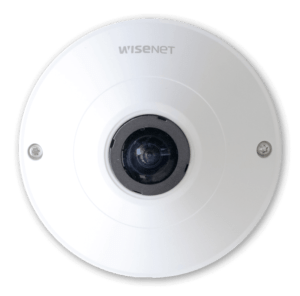
Using modern gaming technology, Solink stretches out this view to give you an immersive look at what is happening at your site.
Here’s the 360 camera at work within Solink:
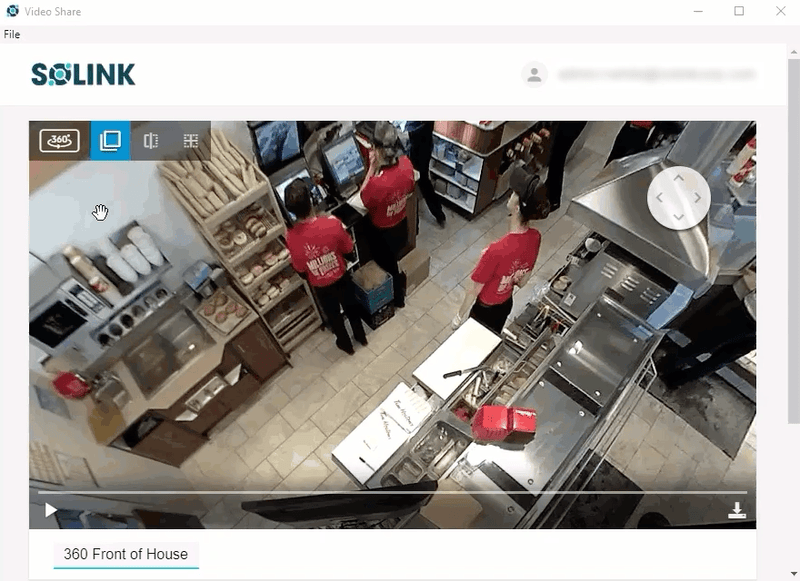
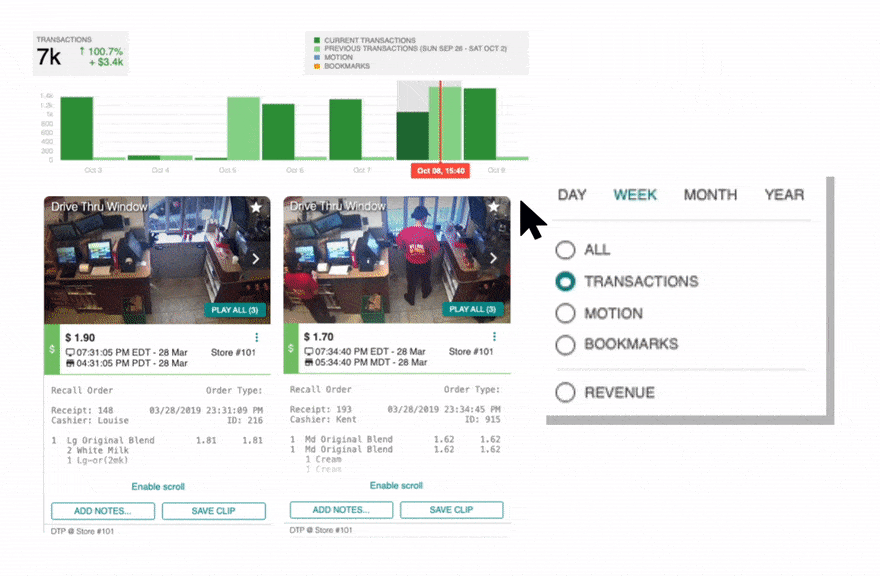
Learn how easy it is to uncover suspicious cash handling in our self-guided tour.
Protect your business today with Solink
Solink’s video analytics and security for businesses makes it easy to create a safe, secure, and healthy environment.
Schedule a product demo with our experts
More differentiating between commercial security camera properties
Commercial security camera systems are complex. There are a lot of decisions to be made on the components. Here’s a list of common comparison points in regards to the security camera systems:
Wired vs. wireless security cameras for commercial buildings
When choosing a commercial security camera system, one key decision is whether to go with wired or wireless cameras. Each option has advantages depending on your business needs.
- Wired cameras offer stable connections, high-quality video, and reliable power but require professional installation and cabling.
- Wireless cameras provide flexibility, easier installation, and remote access but depend on a strong network connection and power source.
Understanding the differences helps businesses select the best setup for their security needs, ensuring reliable coverage and ease of management.
WiFi vs. Ethernet
The first thing to remember when comparing WiFi vs. Ethernet is that this only means a camera is wireless vs. wired for data transmission. WiFi cameras still require energy to work, and that energy usually comes from being plugged into a socket.

However, PoE (power over Ethernet) provides energy and transmission in a single Cat 5 Ethernet cable. That means that WiFi and PoE security cameras both usually still have one wired connection, the only exception being battery WiFi cameras.
WiFi, although resilient to noise, can’t match Ethernet’s speed, reliability, or security. Its range is limited, typically up to 50 ft, with signal weakening beyond. Ethernet cables for IP cameras offer reliable transmission over 300 ft, making them a superior choice for extended distances.
SD vs. HD vs. 4K
Standard definition (SD), high definition (HD), and 4K refer to the resolution at which your commercial security cameras record footage. The higher the resolution, 4K being highest, the better the image quality will be. Classical analog cameras record in SD, although there are some HD analog security cameras on the market.
Conversely, IP cameras have at least HD and sometimes even 4K resolution.

Resolution at its core is how many pixels are recorded in an image. Here’s a summary of the different resolutions:
- SD usually refers to resolutions below 720×480 pixels
- HD usually refers to 1280 x 720 or 1920 x 1080 pixels.
- 4K refers to 3840 x 2160 to 4096 x 2160 pixels.
Pixels are little color dots, and more of them mean the dots are closer together and therefore you can see more details. This might lead you to believe that higher resolution is always better. However, there are several other considerations that should be included in your decision-making process.
Field of view
A camera’s field of view is the angle width (and height) that it is recording. Commercial security cameras have a wide range of fields of view. They can be as low as 40° for zoomed-in smaller cameras and go up to 360° by 180° for a fisheye security camera. The FOV/resolution combination of your cameras dictates the final quality of the video. With the same resolution, a lower field of view will show more details than a larger angle. For this reason, 360 cameras usually have a much higher resolution than other types of security cameras.
Plug-in cameras vs. battery-powered cameras
Battery-powered security cameras absolutely exist. However, their use cases are generally reserved for areas without local electricity connections. In areas where a security camera can be plugged in and/or where continuous 24/7 video recording is required, charging the battery regularly would cause more trouble than any time saved installing a power cord (or PoE connection).
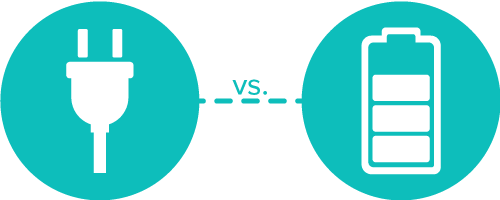
Battery-powered security cameras that only function when triggered, for example by a motion sensor, can last several months on a single charge depending on the level of motion happening in their field of view, so in remote locations with lower security needs they could be useful.
However, Solink recommends against battery-powered security cameras for most scenarios.
Video management systems (VMS) for commercial security camera systems
A video management system (VMS) is the backbone of any commercial security camera system. It organizes, stores, and analyzes video footage, making it easier to monitor security in real time and review past incidents.
Without a VMS, managing multiple cameras can be overwhelming. A strong VMS provides remote access, advanced search functions, AI-powered analytics, and seamless integration with existing security measures. This ensures businesses can quickly respond to threats, improve efficiency, and maximize the value of their security investment.
Top features to look for in a video management system for commercial security cameras
Here are the main things you should be looking for within your video management system to be most effective for your commercial security camera system.
Solink offers all of these things within their cloud-based video platform system, book a demo with us and see exactly what we can offer you going into the future.
The ability to use your existing cameras if you have them already in place
Upgrading your security system doesn’t always mean replacing every camera. A flexible video management system (VMS) allows businesses to integrate existing cameras, reducing costs while enhancing security.
By using compatible VMS software, businesses can add advanced features like remote access, AI-powered analytics, and smart alerts without the expense of a full system overhaul. This approach maximizes your investment while improving security and operational efficiency.
Remote monitoring and camera health checks
A modern security system isn’t just about recording footage—it’s about staying connected to your business anytime, anywhere. Remote monitoring allows you to access live and recorded video from any device, ensuring real-time visibility across multiple locations.
Camera health checks automatically detect issues like offline cameras, recording failures, or tampering. With proactive alerts, businesses can address problems before they compromise security, ensuring continuous protection without manual oversight.
Easy save and search functions
Finding the right footage quickly is essential for effective security. A video management system (VMS) with easy save and search functions allows businesses to locate and download clips in seconds, reducing time spent sifting through hours of video.
Features like keyword tagging, motion-based search, and AI-powered filters help pinpoint incidents fast. This ensures businesses can quickly review events, provide evidence when needed, and improve overall security management.
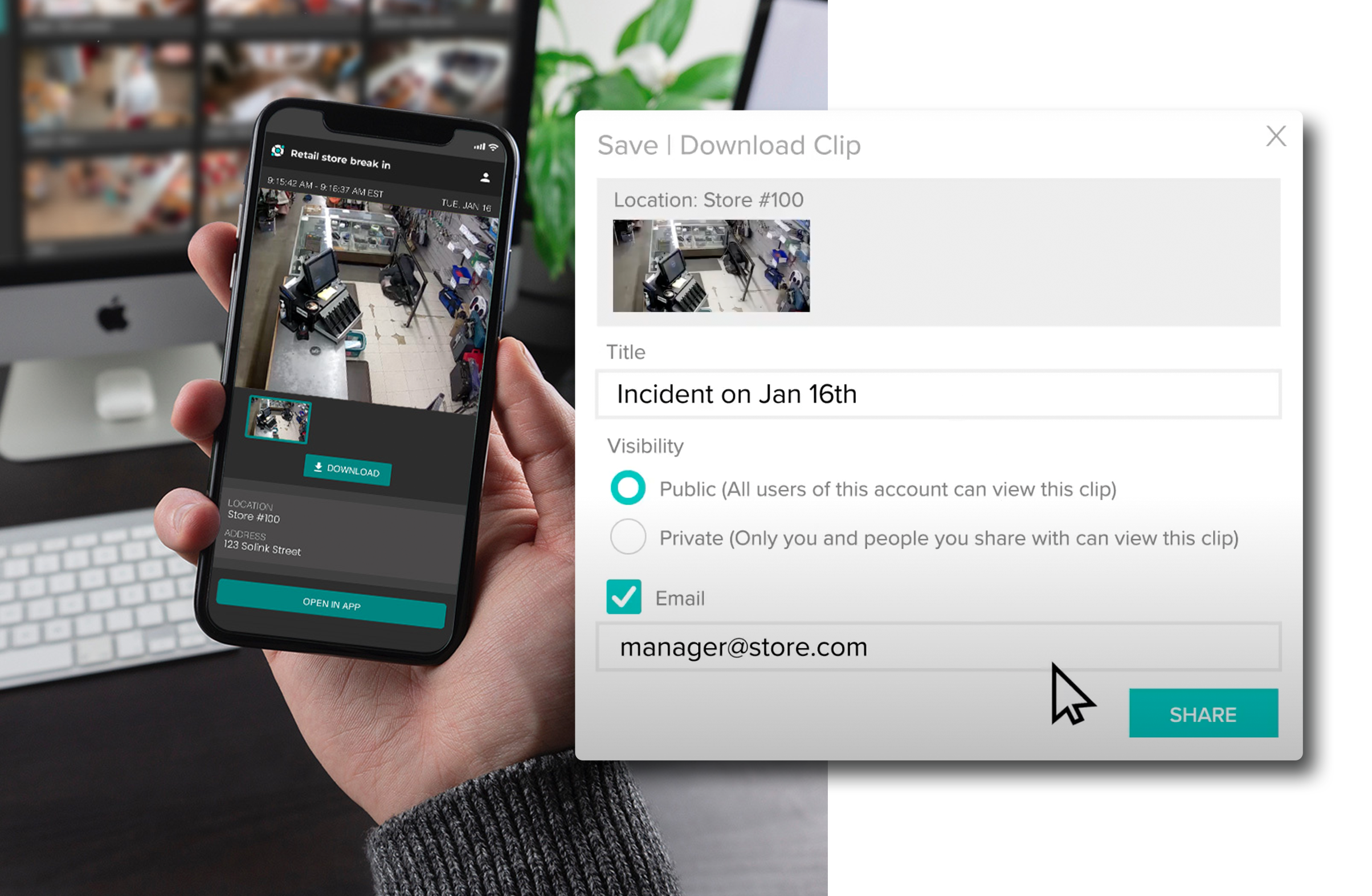
The ability to turn your cameras into alarms (video alarms)
A commercial security camera system does more than record—it can actively prevent threats. Video alarms use motion detection and AI analytics to identify suspicious activity and trigger alerts in real time.
Instead of relying on passive monitoring, businesses get instant notifications when unusual movement is detected, allowing for faster response times. Some systems even integrate with security teams or emergency services, turning cameras into a proactive defense system.
Personalized notification setup
Get the right alerts at the right time with a personalized notification setup. Instead of being overwhelmed with constant motion alerts, businesses can customize notifications based on specific triggers—such as after-hours activity, restricted area access, or unusual movement patterns.
With smart filtering and AI-powered insights, businesses stay informed about real threats while reducing false alarms. This ensures quicker responses to security incidents without unnecessary distractions.
AI-powered capabilities and video analytics
AI-powered video analytics transform security cameras from passive recording devices into intelligent monitoring tools. With features like object recognition, motion tracking, and behavior analysis, businesses can detect threats in real time and reduce false alarms.
These advanced capabilities help identify suspicious activity, track customer flow, and even recognize license plates or faces where permitted. By leveraging AI, businesses improve security, gain valuable operational insights, and respond to incidents faster.
Zone tracking and line crossing data all within an AI security package
Schedule a product demo with our experts
24/7 support and easy installation
A security system is only as good as the support behind it. With 24/7 customer service, businesses get expert help whenever issues arise, ensuring cameras and video management systems stay operational.
Easy installation means businesses can get up and running quickly, whether setting up a new system or upgrading an existing one. With professional guidance and user-friendly technology, security solutions are hassle-free from day one.
The importance of storage for your commercial security camera system
A security camera system is only effective if footage is stored safely and reliably. The right storage solution ensures businesses can access video when needed for investigations, compliance, or incident review.
Storage options include cloud, on-site, and hybrid solutions, each offering different benefits in terms of accessibility, security, and cost. Choosing the right storage method helps businesses retain footage for the required duration while ensuring easy retrieval and protection against data loss.
Cloud vs. on-site storage
When choosing a storage solution for your commercial security camera system, businesses must decide between cloud storage, on-site storage, or a combination of both. Each option has its own benefits and challenges.
Cloud storage
Cloud storage allows businesses to store video footage on remote servers, accessible from anywhere with an internet connection.
Pros:
- Access footage from anywhere with an internet connection.
- Easily scale storage as your business grows.
- Protects against data loss from theft, fire, or hardware failure.
- Automatic updates keep your system secure.
On-site storage
On-site storage involves keeping video footage on local servers, NVRs (network video recorders), or hard drives.
Pros:
- No internet needed—footage is stored and accessed locally.
- One-time hardware investment with no ongoing fees.
- Full control over your video data and security.
Hybrid video storage solutions - best of both worlds
A hybrid storage solution combines the advantages of both cloud and on-site storage, giving businesses flexibility, security, and reliability.
Why Choose Hybrid Storage?
- On-site storage for fast access – Critical footage is stored locally for quick retrieval and uninterrupted recording.
- Cloud storage for backup & security – Important video is automatically backed up to the cloud, protecting against data loss from theft, fire, or hardware failure.
- Scalability without limits – Expand local storage as needed while using the cloud for long-term retention.
- Redundancy for peace of mind – If one storage method fails, the other ensures your footage is safe.
Hybrid storage is ideal for businesses that want fast, reliable access to footage while ensuring long-term security and flexibility. It’s a smart way to balance cost, convenience, and protection.
Choosing the right video storage solution for your business
The best video storage solution depends on your business size, security needs, and how you access footage. Here’s how to decide:
Choose cloud storage if:
- You need remote access from anywhere.
- You want automatic backups and security updates.
- You prefer a scalable, subscription-based model.
Choose on-site storage if:
- You want full control over your data.
- You need uninterrupted recording without internet reliance.
- You prefer a one-time investment with no recurring fees.
Choose hybrid storage if:
- You want the speed of on-site storage with cloud backup for security.
- You need redundancy to prevent data loss.
- You want scalable, long-term storage without sacrificing accessibility.
Matching storage to your business needs ensures reliable access, cost efficiency, and strong data protection—keeping your security system effective and future-proof.
How Solink can help you get the most out of your commercial security cameras
Solink transforms your commercial security cameras into a smart, data-driven security system. With a cloud-based video management system (VMS), AI-powered analytics, and seamless integration, Solink ensures your cameras do more than just record—they actively protect your business.
Why choose Solink?
- Remote access – View live and recorded footage from any device, anytime.
- AI-powered analytics – Detect suspicious activity, reduce false alarms, and improve efficiency.
- Smart video alarms – Turn your cameras into proactive security tools with instant alerts.
- Seamless integration – Use your existing cameras and POS systems for deeper insights.
- Scalable storage – Hybrid cloud solutions ensure secure, flexible video retention.
- 24/7 support & easy setup – Get expert assistance whenever you need it.
With Solink, your security cameras become a powerful business tool, improving safety, reducing loss, and giving you complete control over your operations. Schedule a demo today to see how Solink can enhance your security and business intelligence.
Frequently asked questions about commercial security camera systems
1. What type of commercial security camera is best for my business?
The best camera depends on your needs. Bullet cameras are great for long-range outdoor monitoring, dome cameras offer discreet coverage, PTZ cameras provide flexible movement, and 360-degree cameras capture wide areas without blind spots.
2. What’s the difference between wired and wireless security cameras?
Wired cameras offer a stable connection and unlimited power but require professional installation. Wireless cameras are easier to install and provide remote access but depend on a strong network connection.
3. How long can I store video footage?
Storage duration depends on your system. Cloud storage offers scalable retention, while on-site storage depends on hardware capacity. Many businesses keep footage for 30 to 90 days, but longer retention may be required for compliance.
4. Can I use my existing cameras with a new system?
Yes, if you choose a compatible video management system (VMS) like Solink. This allows you to integrate current cameras while upgrading features like remote access, AI analytics, and smart alerts.
5. What are the benefits of a video management system (VMS)?
A VMS organizes, stores, and analyzes footage, making it easy to search and retrieve video when needed. It also enables remote access, AI-powered analytics, and smart notifications, improving security and efficiency.
6. What’s the best storage option for my security camera system?
Cloud storage provides remote access and automatic backups, while on-site storage offers direct control and no ongoing fees. Many businesses choose a hybrid solution for the best balance of security, accessibility, and cost.
7. Can my security cameras send alerts for unusual activity?
Yes, AI-powered cameras and VMS solutions can detect motion, recognize patterns, and send real-time alerts for suspicious activity. Some systems even integrate with security teams or emergency services.
8. How does Solink improve commercial security camera systems?
Solink enhances security by turning cameras into smart monitoring tools. It offers remote access, AI analytics, video alarms, and easy search functions, ensuring businesses can quickly respond to incidents and improve operations.